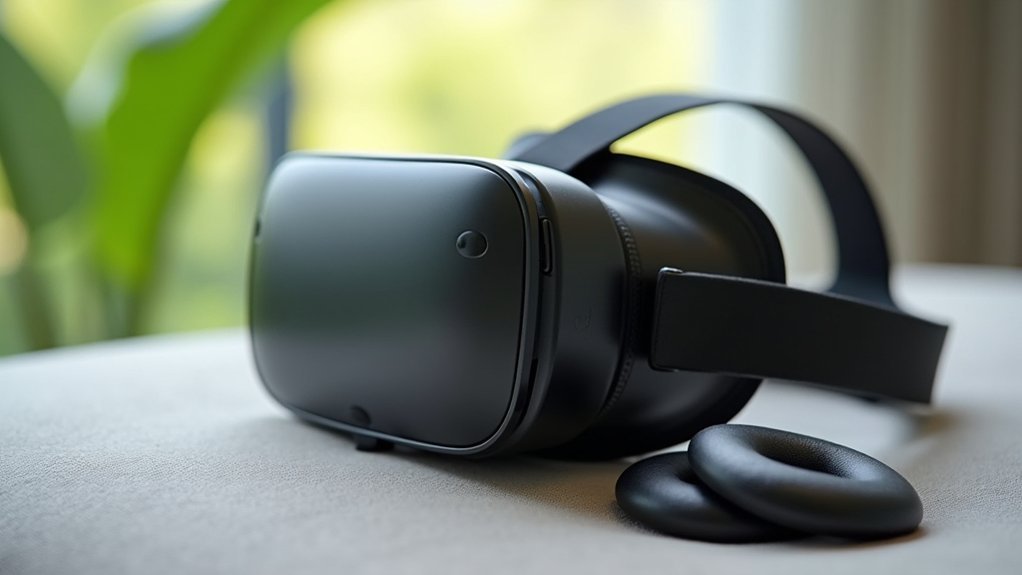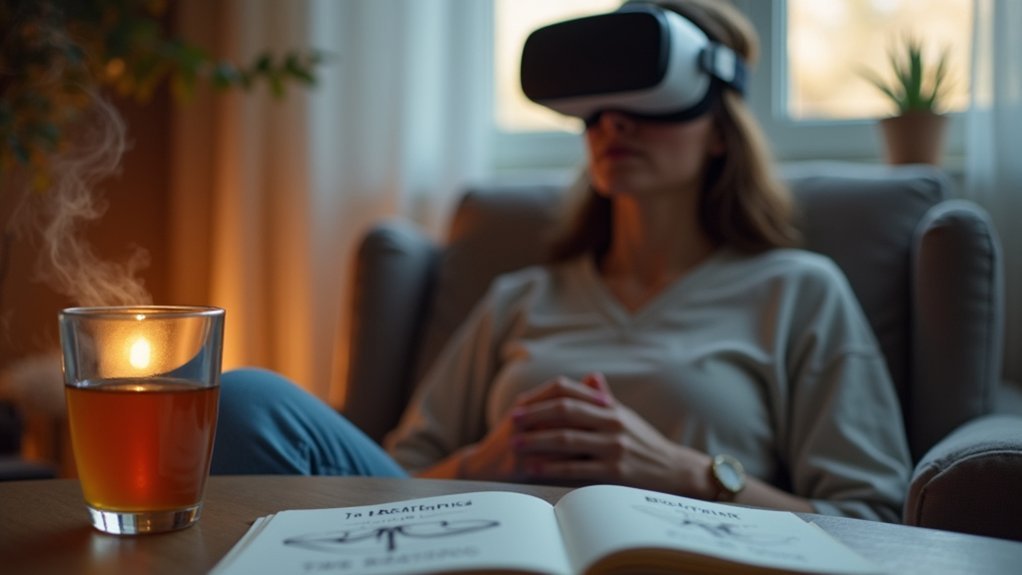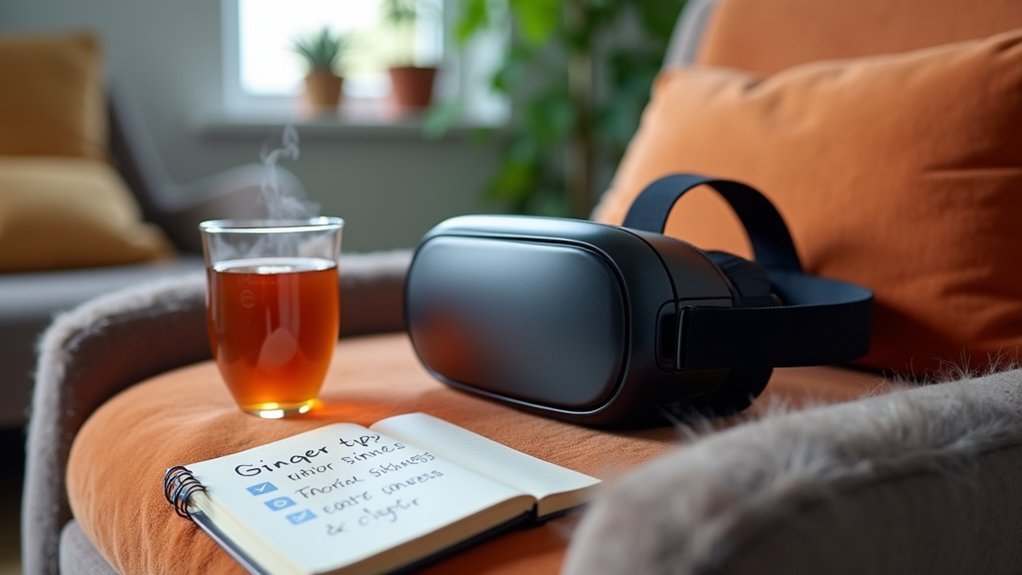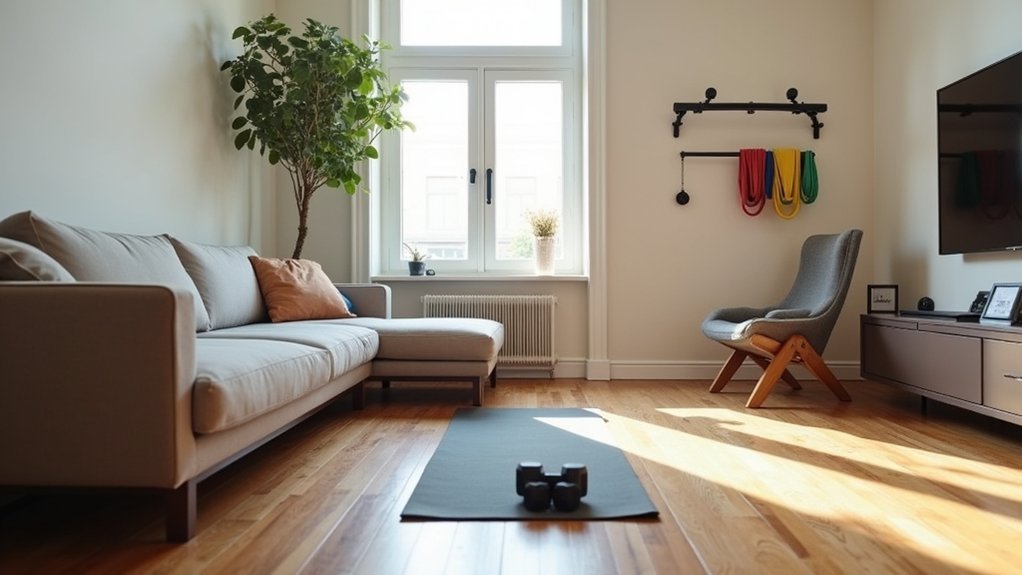To reduce motion sickness in VR headsets: 1) Adjust your headset to fit snugly with proper IPD settings, 2) Start with short 10-minute sessions and gradually increase as you build tolerance, 3) Use teleportation movement instead of smooth locomotion, 4) Keep your play area well-ventilated with moderate temperature, and 5) Stay hydrated and avoid heavy meals before sessions. These adjustments can transform your virtual reality experience from nauseating to enjoyable.
Proper Headset Setup and Fit

While many VR users blame their motion sickness on software or sensitivity, proper headset setup and fit remain the most overlooked causes of discomfort. Ensuring your headset sits snugly—but not painfully tight—on your head stabilizes your view and prevents unnecessary movement.
Position the lenses directly in front of your eyes and adjust the interpupillary distance (IPD) to match your eye spacing. This alignment greatly reduces visual strain and disorientation.
Don’t forget to check that padded straps distribute weight evenly across your head. If you’re experiencing discomfort, try adjusting the face cushioning or adding balance accessories. Adjusting the display brightness level can help reduce sensory overload and make it easier for your brain to process the virtual environment. Clean face pads regularly to prevent slipping from sweat buildup.
Optimizing Display Settings and IPD Adjustment
Although many users focus solely on software comfort features, proper display settings and IPD adjustment form the foundation of a comfortable VR experience. Correctly setting your interpupillary distance (IPD) guarantees the display aligns with your unique eye spacing, markedly reducing eye strain and disorientation.
Lower your headset’s brightness to minimize sensory overload, particularly during extended sessions. Take advantage of comfort settings offered in VR games that reduce visual jarring. Experimenting with various comfort settings can help identify the optimal configuration for your personal comfort level.
For enhanced stability, use environments with clear 3D spatial references and consider reducing your field of view initially.
Consider whether sitting might help you maintain stability, especially when experiencing discomfort. Headsets with 6DoF tracking provide better spatial awareness, reducing motion sickness.
Remember that proper ventilation and air circulation in your physical space can also alleviate nausea symptoms.
Building VR Tolerance Through Gradual Exposure

Developing resistance to VR motion sickness resembles training for physical activities—your body needs time to adapt to new sensory experiences.
Start with sessions under 10 minutes, gradually extending duration as your tolerance improves.
Begin in simple, low-contrast environments before progressing to visually complex scenes.
When moving in VR, use teleportation techniques initially rather than artificial locomotion, and align your real-world posture with your virtual one.
Take frequent breaks between sessions to prevent symptom buildup.
Sitting can help stabilize your posture while you’re still adjusting, and proper airflow keeps discomfort at bay.
Women and older adults should be particularly mindful as gender and age can significantly influence susceptibility to VR sickness.
Creating Comfortable Environmental Conditions
Environmental factors play five critical roles in managing VR motion sickness. Verify your space is well-ventilated with fresh air circulation to reduce nausea and improve comfort during sessions.
Maintain a moderate room temperature—neither too warm nor too cold.
Set up your physical space thoughtfully. Use a chair for seated experiences to stabilize your orientation, and keep your play area free from obstacles. Stable surfaces provide crucial support that significantly reduces the vestibular conflict causing motion sickness symptoms.
Consistent, stable lighting in your room prevents disorientation when shifting between real and virtual worlds.
Control ambient sound levels and minimize unexpected noises that could trigger discomfort. Consider using soft background music to create a calming atmosphere.
Finally, optimize your headset’s display by reducing brightness and using glare-reducing features to minimize visual strain that contributes to motion sickness.
Physical Preparations to Prevent Nausea

Beyond optimizing your physical environment, preparing your body before VR sessions can greatly reduce motion sickness symptoms.
Engage in vestibular training exercises like gaze stabilization and balance activities to strengthen your motion tolerance.
Incorporate daily vestibular exercises to build your VR resilience and gradually extend your comfortable play time.
Try habituation exercises by gradually exposing yourself to movements that trigger mild discomfort—using swing sets, rocking chairs, or controlled car rides as training grounds.
Standing on one leg or walking heel-to-toe can improve your balance and stability.
Don’t overlook mental preparation: practice relaxation techniques and positive visualization before sessions.
Simple lifestyle adjustments make a difference too—stay hydrated, avoid heavy meals, and guarantee you’re well-rested before using your headset.
Regular physical activity improves your overall resilience to motion sensitivity, making VR experiences more enjoyable.
Start with small doses of exercises that trigger mild symptoms that resolve within 3-5 minutes to avoid prolonged sickness.
Frequently Asked Questions
Can Prescription Medications Help With VR Motion Sickness?
Yes, prescription medications can help reduce your VR motion sickness. Antihistamines like Dramamine and anticholinergics like scopolamine patches work best when taken before symptoms start. Consult your healthcare provider about potential side effects first.
How Do Wireless Versus Wired Headsets Affect Motion Sickness?
Wireless headsets reduce motion sickness by allowing free movement without cable restrictions, while wired options offer lower latency with less audio-visual delay. Your sensitivity to either tethering constraints or signal lag will determine which works better.
Do Age or Gender Influence Susceptibility to VR Nausea?
Yes, age and gender influence VR nausea. You’re likely more susceptible if you’re female, very young, or elderly. Children under 12 experience less motion sickness, while hormonal factors can increase women’s sensitivity.
Can VR Motion Sickness Have Long-Term Health Effects?
Current research doesn’t strongly support long-term health effects from VR sickness. You’ll typically experience only short-term symptoms that resolve quickly. However, if you’re particularly susceptible, you should monitor your reactions and take regular breaks.
How Do Different VR Locomotion Methods Affect Motion Sickness?
Different VR locomotion methods impact motion sickness considerably. You’ll experience less discomfort with teleportation compared to walking-in-place. Arm-swinging offers immersion but may cause sickness, while controller navigation balances comfort and usability.
In Summary
By implementing these five strategies, you’ll greatly reduce your motion sickness in VR. Proper headset fit, optimized display settings, gradual exposure training, comfortable surroundings, and physical preparation all work together to enhance your experience. Don’t let nausea hold you back from enjoying virtual worlds. With consistent application of these techniques, you’ll build stronger VR tolerance and enjoy longer, more comfortable immersive sessions.





Leave a Reply